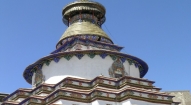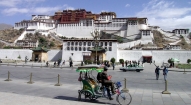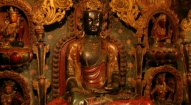- Home |
- Why With Us |
- About Us |
- Booking |
- Contact Us |
- Site Map


Kharta Valley Tour and Trek
Days from
The highest of the great mountains of the world seems to require single gesture of mastery in order to establish as the queen of them all, immense in its solitary and unrivalled supremacy. The remarkable spectacles offered by the icy mass of Everest, which loom over the desert highlands of Tibet, are as enchanting today as they did since centuries.
The highest of the great mountains of the world seems to require single gesture of mastery in order to establish as the queen of them all, immense in its solitary and unrivalled supremacy. The remarkable spectacles offered by the icy mass of Everest, which loom over the desert highlands of Tibet, are as enchanting today as they did since centuries.
To the north, the great mountains look out directly over an arid, inhospitable highland, where the presence of human is infrequent and limited. Here, more than to the south the presence of human monuments and civilization is quite surprising. This challenging yet rewarding trek will lead you through miles of steep valleys, high passes, and gorgeous glacial lakes. Trekkers will be shown some of the most spectacular Himalayan scenery anywhere on earth. Snow-covered mountain peaks will be coupled with astounding flowering valleys in the warmer seasons. The highlight of the trip for many is the remote Kangshung valley, often referred to as the valley of flower. Lingam La, at a height of 5320 meters, is the highest point we will encounter on this amazing trek. The view from this point on a clear day is unparalleled in its beauty. Dozens of vast snow covered peaks including Makalu, Lhotse Shar, Lhotse and Mount Everest can be seen to the south. Below the snow line of these massive peaks lie valleys and ridges, bountifully covered with various grass and thick vegetation.

Day 01: Arrive in Kathmandu. Transfer to hotel
Day 02: Full day Kathmandu sightseeing.
Day 03: Flight: Kathmandu - Lhasa (3660m). Overnight at hotel
Day 04: Sightseeing in Lhasa
Today will be spent visiting several of Lhasa's many monasteries in the company of a guide and interpreter. One of these is the Sera Monastery, one of the best-preserved monasteries in Tibet. Within its whitewashed walls and golden roofs, several hundred monks live and study. After lunch we'll visit the Norbulingka, the summer palace of the Dalai Lama, as well as the Jokhang Temple. This temple is possibly the most sacred shrine in Tibet and there is always a procession of devout Tibetans through the complex. Surrounding the Jokhang is the Barkor - a maze of narrow cobbled streets that is the central market of Lhasa.
Day 05: Sightseeing in Lhasa:
This morning we will visit the Potala Palace, which dominates the city of Lhasa. A spectacular building, it contains the private quarters of the Dalai Lama as well as numerous grand staterooms and many important chapels. There has been a palace on this site since the 5th or 6th century, but the present palace was constructed in the 17th century. A visit to the Drepung Monastery this afternoon will complete a truly awe- inspiring day. Founded in the 14th century, this monastery was once the largest in the world with a population of around 10,000 monks. These days that figure is down to several hundred, but there is still much here of interest as it was left relatively unscathed during the Cultural Revolution.
Day 06: Drive Lhasa – Gyantse (3950m) 261 km.
Today we start our overland journey towards Kathmandu. Travelling by jeep along the Friendship Highway we cross the Khamba La [4794m] from which there is stunning views across the waters of Yamdrok-tso Lake to the snowy summit of Nazin Kang Sa (7252m). We continue westwards over another high pass the Karo La [5045m] where we are treated to the spectacular sight of a huge glacier tumbling down to within a few hundred metres of the road. After passing through beautiful valleys and colourful Tibetan villages we arrive in the town of Gyantse. Overnight Hotel.
Day 07: Drive Gyantse (3950m) –Shigatse (3900m)
Before leaving Gyantse we have time this morning to visit the Gyantse Dzong and Gyantse Kumbum. The Dzong is a fort dating from the 14th century from which there are amazing views of both Gyantse itself and the surrounding Nyang Chu Valley. The Kumbum is a large gold-domed stupa and its many small chapels house an impressive array of Tibetan Buddhist murals.
We then continue on to Shigatse, a short drive of only 90kms, arriving in time for lunch. Shigatse is the second largest city in Tibet and after exploring the local market we will make a detailed visit to the Tashilhunpo Monastery. This monastery is one of the largest functioning monasteries in Tibet and there is much to explore within its high surrounding walls. Overnight at Hotel.
Day 08: Shigatse [3900m] – Shegar [4050m] 244km
Today we continue along the Friendship Highway, marveling once more at the barren yet spectacular landscape of Tibet. Beyond the small town of Lhatse we cross the highest pass on our journey, the Gyamtso La [5220m]. From here we descend to the plains, passing lonely monasteries and the camps of nomadic herders, en route to Shegar and our overnight accommodation at Hotel Quomolongma.
Day 09: Shekar – Kharta (12300)
Drive five hours to Kharta, enjoying beautiful views from the Pang La (17000) towards Makalu, Lhotse, Everest and Shisapangma (if weather is clear). Drive down the Dzakaa Chu and then the Phung Chu valley toward Kharta. We’ll make camp past the boarding school on the banks of the Kharta Tsangpo River, the headwaters of Nepal’s Arun River.
Day 10: Begin Trek
Hike up the Kharta Tsangpo valley past several villages. The trail to the Shao La leaves the Kharta valley and climbs steadily up a side valley to the south. We’ll camp either at the beginning of this climb on a ledge overlooking the valley and its villages (at approximately 13000 feet) or continue up the side valley following a small stream for another two hours to camp on meadows by the stream (14,000) (4 hours hiking).
Day 11: Sho La
Ascend steadily over rocky ground to reach the Shao La (16300) in about two hours. Weather permitting; the views from here toward Makalu, Lhotse, and Everest are stunning. Once at the top of the pass we descend for about an hour and then plunge steeply to the valley below. At once the scene changes from barren rock slopes to lush rhododendrons, birch, and willow trees. Continue one hour down this valley to camp at Joksum, following a stream through thick fir and juniper forests. (4 hours hiking).
Day 12: Trek
Hike steeply through juniper and rhododendron forests to reach the high pastures above the Kama River. On clear days, we’ll see splendid views toward Everest and Lhotse. The high ridges south of the Kama River drip with hanging glaciers and in the spring are alive with bellowing avalanches. We continue to traverse alpine meadows and pass yak herders’ camps and a serene green lake to a campsite (14500) on large meadows and pass yak herders’ camps and a serene green lake to a campsite (14500) on a large meadow with great views of the Khangshung Valley. (5 hours hiking).
Day 13: Trek
Hike up a ridge affording a clear sight right up the Khangshung Valley, with views of Everest, Lhotse, Lhotse Shar, Tshertse, Petangtse, Chomolonzo, Makalu and a myriad of other great peaks. From this ridge we descend rather steeply down to the Kama River coming from the Langma La. After wading across the river we enter the Khangshung Valley, a wide valley drained by the Khangshung Valley, a wide valley drained by the Khangshung stream. A receding glacier ahs left behind wide undulating hillocks now covered by a thick growth of willow, rhododendron, juniper, and other shrubs. Camp at the meadow called Pethang (14200), about an hour’s walk uphill from the stream crossing.
Day 14: Pethang Ringmo
Hike steeply up onto a large rockslide. The views of Makalu and the incredible upheaval caused by the Chomolonzo glaciers are amazing. After the rockslide the trail traverses around the mountainside to reach a beautiful glade, locally called Opka. Continue hiking up meadows of lateral moraine with views of Everest, Lhotse, and Tserse to reach camp on the grassy knolls of Pethang Ringmo (16000). (4-5 hours hiking.)
Day 15: Khangshung Valley
Optional day hikes up the Khangshung Valley alongside the glacier to the base camp (17000) used by expeditions attempting the east face of Everest.
Day 16: Raabka Chu
Retrace our steps down the valley along the Khangshung Glaciers, across the rockslide opposite the Chomolonzo glacier, and past Pethang to a stream crossing at the Raabka Chu. The camp (13500) on the grassy meadow across the river is a very pleasant place to spend the afternoon. (4 hours hiking.)
We can also reach this campsite from Pethang Ringmo by taking a side trip to Guru Rimpoche’s cave at Tse Chu Lake. The trail climbs high above Okpa meadows, crosses Lamtsho (16200), then descends steeply to the lake. (6-7 hours hiking.)
Day 17: Rabka Chu To Tso Tshuringma
Hike steadily uphill, steeply at first for an hour to a shelf above the river, then another hour across relatively flat ground to a small meadow called Pangboche, where we have lunch. Continue to hike steeply over alpine slopes for another couple of hours to a small but beautiful lake at the base of the Langma La (17500). The views of Makalu and Everest are great from here! Camp at Tsho Tshurigma (16000) (4 hours hiking.)
Day 18: Tsho Tshurigma – Troshay Medow Camp
Climb steeply over rocky ground to reach the Langma La (17500) in just over two hours. En route we pass another lake, and the views of Makalu become more impressive as we climb upwards, while Everest and all the other attendant peaks are visible all the way to the pass. From Langma La we bid farewell of the Khangshung Valley and the impressive panorama of some of the world’s highest mountains, and then descend steeply four hours over rocky moraines and glaciated valleys. Camp is on a grassy meadow beside a clear stream at Troshay (14000). (6 hours hiking.)
Day 19: Troshay to Kharta
We follow the stream from camp down the Kharta Tsangpo valley along a well defined trail. We’ll hike across grassy hillsides used for grazing animals and past villages with barley and potato fields ringed by willows and birch. After two hours we reach the fork of the trail where we climbed to Shao La at the beginning of the trek. Cross the river below Yulba village and reach our riverside campsite where we started the trek
Day 20: Rongbuk Monastery
Drive five to six hours to Rongbuk monastery (16400), the highest monastery in the world and a shrine dedicated to Everest, is the last sign of habitation before commencing the trek to Everest via the north face. We spend a night here; this is a good place to read a book: just how often do you get a chance to sit and read at 5000m and with the stunning view of Everest's north face. It is very important that we take our time and gets very well acclimatised before we go to the ABC. Today we will explore the surroundings of the Rongbuk Everest base camp, just to get started working a little.
Day 21: Drive Rongbuk (5000m) – Nyalam, 215 km
Today we rejoin the Friendship Highway and drive to Tingri. Upon leaving Tingri, we cross another two high passes, the Lalung La [5124m] and the Shung La [5200m]. Once more we are rewarded with magnificent views of the surrounding peaks of Shishapangma, Cho Oyu, Menlungtse and Gauri Shankar. Now we begin our descent from the Tibetan Plateau to Nyalam just 30 km before the Nepalese border. With dramatic suddenness, everything appears incredibly lush and green.
Day 22: Drive Nyalam – Kathmandu (1400m) 153 km
From Nyalam we drive the last 30 kilometres to the Friendship Bridge, which spans the Bhote Koshi River and marks the Chinese - Nepalese border. We say goodbye to the Tibetan guide and driver and walk to Nepalese Immigration Control in Kodari where our Nepalese staff will meet us. After completing the re-entry formalities we continue the drive to Kathmandu, which, depending on road and weather conditions, should take about 5 hours.
Day 23: Free Day in Kathmandu
Day 24: Final Departure





